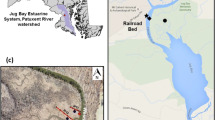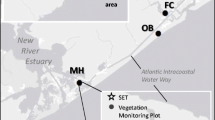Abstract
An analysis of data relatingSpartina alterniflora Loisel. to tidal elevations along the Atlantic and Gulf coasts demonstrated that although this species is primarily confined to the intertidal zone, its elevational limits. of occurrence do not correspond to a consistent elevation relative to a tidal datum in all marsh locations. The variation in the vertical distribution of this species reported among marsh studies was attributed primarily to differences in mean tide range (MTR). A positive correlation between MTR and elevational growth range (r=0.91) demonstrated that theSpartina alterniflora zone expands with increasing tidal amplitude. Differences in MTR among marsh locations accounted for 70 and 68% of the statistical variation in the upper and lower limits, respectively, ofS. alterniflora growth. Among marshes of similar tidal amplitudes, the upper limit of occurrence ofS. alterniflora in northern marshes was significantly lower than that in marshes at lower latitudes. These results, in combination with regional differences in plant species distribution across the upper intertidal zone, suggested that some of the variation in the upper limit was due to latitudinal differences in growth conditions and/or differences in interspecific competition. Local and regional differences in other factors such as salinity, nutrients, or physical disturbance may have also contributed to the variation in the limits of growth relative to a tidal plane within and among marshes.
Similar content being viewed by others
Literature cited
Adams, D. A.. 1963. Factors influencing vascular plant zonation in North Carolina salt marshes.Ecology 44:445–456.
Armstrong, W., E. J. Wright, S. Lythe, andT. J. Gaynard. 1985. Plant zonation and the effects of the spring-neap tidal cycle on soil aeration in a Humber salt marsh.J. Ecol. 73: 323–339.
Ball, M. C. 1980. Patterns of secondary succession in a mangrove forest of southern Florida.Oecologia44:226–235.
Barbour, M. G. 1978. The effect of competition and salinity on the growth of a salt marsh plant species.Oecologia (Berlin) 37:93–99.
Bartoldus, C. C. 1986. Relationship of salt marsh vegetation to tidal data at the Lloyd Point Marsh, Long Island, New York, (abstract). Society of Wetland Scientists Seventh Annual meeting, May 1986, Biloxi, Missisippi.
Bertness, M. D., andA. M. Ellison. 1987. Determinants of pattern in a New England salt marsh plant community.Ecol. Monogr. 57:129–147.
Boon, J. D., M. E. Boule, andG. M. Silberhorn. 1977. Delineation of tidal wetlands boundaries in lower Chesapeake Bay and its tributaries. Special Rep. No. 140, Applied Marine Science and Ocean Engineering, Virginia Institute of Marine Science, Gloucester Point, Virginia, 127 p.
Bourn, W. S., and C. Cottam. 1950. Some biological effects of tidewater marshes. US Dept. Int. Rep. No. 19.
Chapman, V. J. 1940. Studies in salt marsh ecology; Section VI and VII. Comparisons with marshes on the east coast of North America.J. Ecol. 28:118–151.
Chapman, V. J. 1960. Salt Marshes and Salt Deserts of the World. Interscience, New York. 392 p.
Conard, H. S. 1935. The plant associations of Central Long Island.Am. Midl. Nat. 16:433–516.
Cooper, A. 1982. The effects of salinity and waterlogging on the growth and cation uptake of salt marsh plants.New Phytol. 90:263–275.
Eilers, H. P. 1981. Production in coastal salt marshes of southern California. EPA Report No. 600/3-81-023. 88 p.
Eleuterius, L. N., andC. K. Eleuterius. 1979. Tide levels and salt marsh zonation.Bull. Mar. Sci. 29:394–400.
Environmental Laboratory 1987. Corps of Engineers Wetland Delineation Manual. Technical Report Y-87-1. U.S. Army Engineers Waterways Experiment Station, Vicksburg, Mississippi. 100 p. plus appendices.
Flowers, M. G. 1973. Vegetational zonation in two successional brackish marshes of the Chesapeake Bay.Chesapeake Sci. 14:197–200.
Ganong, W. F. 1903. The vegetation of the Bay of Fundy salt and diked marshes: An ecological study.Bot. Gaz. 36:161–186, 280–302, 340–367, 429–455.
Garwood, P. E., andR. L. Vadas. 1986. Experimental demonstration of competition betweenSpartina alterniflora andS. patens in a northern New England salt marsh. (abstract). American Society of Limnology and Oceanography, June 22–26, University of Rhode Island, Kingston, Rhode Island.
Grace, J. B., andR. Wetzel. 1981. Habitat partitioning and competitive displacement in cattails (Typha): Experimental field studies.Am. Nat. 113:463–474.
Gray, A. J., andR. G. H. Bunce. 1972. The ecology of Morecambe Bay. VI. Soils and vegetation of the salt marshes: A multivariate approach.J. Appl. Ecol. 9:221–234.
Gray, A. J., andR. Scott. 1977. The ecology of Morecambe Bay. VII. The distribution ofPuccinellia maritima, Festuca rubra, andAgrostis stolonifera in the salt marshes.J. Appl. Ecol. 14:229–241.
Greulich, P. E. 1978. Nearly flat to the transit-MHW vs. vegetation.Surveying and Mapping 38:221–229.
Harshberger, J. W. 1909. The vegetation of the salt marshes of northern coastal New Jersey.Proc. Acad. Nat. Sci. Phila. 61:373–400.
Hawkes, A. L. 1966. Coastal wetlands—problems and opportunities.Trans. N. Am. Wildl. Nat. Resour. Conf. 31:59–77.
Hinde, H. P. 1954. The vertical distribution of salt marsh phanerogams in relation to tide levels.Ecol. Monogr. 24:209–225.
Howes, B. L., R. W. Howarth, J. M. Teal, andI. Valiela. 1981. Oxidation-reduction potentials in a salt marsh: Spatial patterns and interactions with primary production.Limnol. Oceanogr. 26:350–360.
Hughes, V. 1975. The relationship between the upper limit of coastal marshes and tidal datums. National Ocean Survey Rep. No. SFB 3.6-1/6. 84 p.
Johnson, D. S., and H. H. York. 1915. The relation of plants to tide levels. Carnegie Inst. Wash. Publ. 206, Washington, D.C.
King, G. M., M. J. Klug, R. G. Wiegert, andA. G. Chalmers. 1982. Relation of soilwater movement and sulfide concentration toSpartina alterniflora production in a Georgia salt marsh.Science 218:61–63.
Kurtz, H., and K. Wagner. 1957. Tidal marshes of the Gulf and Atlantic coasts of northern Florida and Charleston, South Carolina, Florida State Univ. Studies 24, Tallahassee, Florida. 168 p.
Lagna, L. 1975. The relationship ofSpartina alterniflora to mean high water. New York Sea Grant Institute, Stony Brook, New York: NYSSGp-RS-75-002. Mar. Sci. Research Center, State Univ. New York at Stony Brook, 48 p.
Lefor, M. W., W. C. Kennard, andD. L. Civco. 1987. Relationships of salt-marsh plant distributions to tidal levels in Connecticut, USA.Environ. Management 11:61–68.
Mahall, B. E., andR. B. Park. 1976a. The ecotone betweenSpartina foliosa Trin. andSalicornia virginica L. in salt marshes of northern San Francisbo Bay: II Soil water and salinity.J. Ecol. 64:783–809.
Mahall, B. E., andR. B. Park. 1976b. The ecotone betweenSpartina foliosa Trin. andSalicornia virginica L. in salt marshes of northern San Francisco Bay: III. Soil aeration and tidal immersion.J. Ecol. 64:811–819.
Mendelssohn, I. A., andE. D. Seneca. 1980. The influence of soil drainage on the growth of salt marsh cordgrassSpartina alerniflora in North Carolina.Estuarine Coastal Mar. Sci. 11: 27–40.
Mendelssohn, I. A., K. L. McKee, andW. H. Patrick, Jr. 1981. Oxygen deficiency inSpartina alterniflora roots: Metabolic adaptation to anoxia.Science 214:439–441.
Miller, W. R., andF. E. Egler. 1950. Vegetation of the Wequetoquock-Pawcatuck tidal marshes, Connecticut,Ecol. Monogr. 20:143–172.
Nestler, J. 1977. Interstitial salinity as a cause of ecophenic variation inSpartina alterniflora.Estuarine Coastal Mar. Sci. 16: 103–109.
Nichols, G. E. 1920. The vegetation of Connecticut. VII. The associations of depositing areas along the seacost.Torrey Bot. Club. Bull. 47:511–538.
Niering, W. A., andR. S. Warren. 1980. Vegetation patterns and processes in New England salt marshes.Bioscience 30:301–307.
Nixon, S. W. 1982. The ecology of New England high salt marshes: A community profile. U.S. Fish and Wildlife Service, Office of Biological Services, FWS/OBS-81/55. 70 p.
Pielou, E. C., andR. D. Routledge. 1976. Salt marsh vegetation: Latitudinal gradients in the zonation patterns.Oecologia 24:311–321.
Pigott, C. D. 1969. Influence of mineral nutrition on the zonation of flowering plants in coastal salt marshes, p. 25–35.In I. H. Rorison (ed.), Ecological Aspects of the Mineral Nutrition of Plants. Black well Scientific Publications, Oxford.
Porro, A. A., Jr. andJ. P. Weidener. 1982. The Borough case.Surveying and Mapping 42:369–375.
Redfield, A. C. 1972. Development of a New England salt marsh.Ecol. Monogr. 42:201–237.
Reed, J. F. 1947. The relation of theSpartinetum glabrae near Beaufor, North Carolina, to certain edaphic factors.Am. Midl. Nat. 38:605–614.
Shalowitz, A. L. 1962. Shore and sea boundaries. US Dept. Comm. Publ. 10-1. 420 p.
Snow, A. A., andS. W. Vince. 1984. Plant zonation in an Alaskan salt marsh. II. An experimental study of the role of edaphic conditions.J. Ecol. 72:669–684.
Steever, E. Z. 1972. Productivity and vegetation studies of a tidal salt marsh in Stonington, Connecticut; Cottrell marsh. M.A. Thesis., Connecticut College, New London. 73 p.
Thomas, D. 1983. The establishment of the mean high water line at the Bird Island and Gallinas Creek Marsh areas of San Francisco Bay. Final Rep. to US Army Corps of Engineers, San Francisco District, San Francisco, California, 39 p.
U.S.Dept. of Commerce 1972–1985. Tide Tables, East Coast of North and South America. US Dept. of Commerce, National Ocean Survey. 285 p.
Valiela, I., andJ. M. Teal. 1974. Nutrient limitation in salt marsh vegetation, p. 547–563.In R. J. Reimold and W. H. Queen (eds.), Ecology of Halophytes. Academic Press, New York.
Webb, J. W. 1983. Soil water salinity variations and their effects onSpartina alterniflora.Contrib. Mar. Sci. 26:1–13.
Wilson, S. D., andP. A. Keddy. 1985. Plant zonation on a shoreline gradient: Physiological response curves of component species.J. Ecol. 73:851–860.
Wilson, S. D., andP. A. Keddy. 1986. Species competitive ability and position along a natural stress/disturbance gradient.Ecology 67:1236–1242.
Zedler, J. B. 1986. Catastrophic flooding and distributional patterns of Pacific cordgrass (Spartina foliosa Trin).Bull. South. Calif. Acad. Sci. 85:74–86.
Zedler, J. B., J. Covin, C. Nordby, P. Williams, andJ. Boland. 1986. Catastrophic events reveal the dynamic nature of saltmarsh vegetation in southern California.Estuaries 9:75–80.
Author information
Authors and Affiliations
Rights and permissions
About this article
Cite this article
McKee, K.L., Patrick, W.H. The relationship of smooth cordgrass (Spartina alterniflora) to tidal datums: A review. Estuaries 11, 143–151 (1988). https://doi.org/10.2307/1351966
Received:
Accepted:
Issue Date:
DOI: https://doi.org/10.2307/1351966




